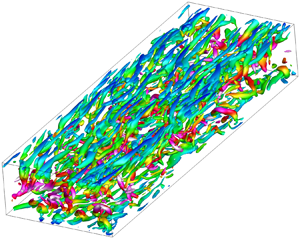Crossref Citations
This article has been cited by the following publications. This list is generated based on data provided by
Crossref.
Zhang, Bo
2023.
Nonlinear mode decomposition via physics-assimilated convolutional autoencoder for unsteady flows over an airfoil.
Physics of Fluids,
Vol. 35,
Issue. 9,
Martin-Linares, Cristina P.
Psarellis, Yorgos M.
Karapetsas, George
Koronaki, Eleni D.
and
Kevrekidis, Ioannis G.
2023.
Physics-agnostic and physics-infused machine learning for thin films flows: modelling, and predictions from small data.
Journal of Fluid Mechanics,
Vol. 975,
Issue. ,
Xu, Dehao
Wang, Jianchun
and
Chen, Shiyi
2023.
Reynolds number and wall cooling effects on correlations between the thermodynamic variables in hypersonic turbulent boundary layers.
Journal of Fluid Mechanics,
Vol. 965,
Issue. ,
Wang, Yunpeng
Yuan, Zelong
and
Wang, Jianchun
2023.
Ensemble data assimilation-based mixed subgrid-scale model for large-eddy simulations.
Physics of Fluids,
Vol. 35,
Issue. 8,
Tan, Jiangtao
and
Jin, Guodong
2024.
An artificial neural network model for recovering small-scale velocity in large-eddy simulation of isotropic turbulent flows.
Physics of Fluids,
Vol. 36,
Issue. 8,
Li, Jiaqi
Bin, Yuanwei
Huang, George
and
Yang, Xiang I.
2024.
Enhancing generalizability of machine-learning turbulence models.
Luo, Tengfei
Li, Zhijie
Yuan, Zelong
Peng, Wenhui
Liu, Tianyuan
Wang, Liangzhu (Leon)
and
Wang, Jianchun
2024.
Fourier neural operator for large eddy simulation of compressible Rayleigh–Taylor turbulence.
Physics of Fluids,
Vol. 36,
Issue. 7,
Li, Xinyu
Zhu, Xiangqian
Sun, Mingqi
Qu, Yanpeng
Liu, Kai
Pei, Yanliang
and
Choi, Jin-Hwan
2024.
Surrogate model-based optimization of drogue dimensions and towing operations to straighten deep-towed nonuniform arrays.
Ocean Engineering,
Vol. 299,
Issue. ,
p.
117321.
Wang, Yunpeng
Li, Zhijie
Yuan, Zelong
Peng, Wenhui
Liu, Tianyuan
and
Wang, Jianchun
2024.
Prediction of turbulent channel flow using Fourier neural operator-based machine-learning strategy.
Physical Review Fluids,
Vol. 9,
Issue. 8,
Nabavi, Miralireza
and
Kim, Jeonglae
2024.
Optimising subgrid-scale closures for spectral energy transfer in turbulent flows.
Journal of Fluid Mechanics,
Vol. 982,
Issue. ,
Ren, Xingsi
Xu, Dehao
Wang, Jianchun
and
Chen, Shiyi
2025.
Artificial-neural-network-based subgrid-scale models in the strain-rate eigenframe for large-eddy simulation of compressible turbulent channel flow.
Physical Review Fluids,
Vol. 10,
Issue. 1,
Wan, Teng
Zhou, Mingshuo
Zhao, Pinghui
and
Wang, Xingjian
2025.
Challenges in the modeling and simulation of turbulent supercritical fluid flows and heat transfer.
Propulsion and Energy,
Vol. 1,
Issue. 1,
Zhou, Zhideng
Zhang, Xin-lei
He, Guo-wei
and
Yang, Xiaolei
2025.
A wall model for separated flows: embedded learning to improve a posteriori performance.
Journal of Fluid Mechanics,
Vol. 1002,
Issue. ,
Hou, Ximeng
Chang, Ning
Yuan, Zelong
Wang, Yunpeng
Peng, Huaiwu
Zhang, Rikui
and
Wang, Jianchun
2025.
Large eddy simulation modeling of incompressible turbulence governed by vorticity transport equations.
Physics of Fluids,
Vol. 37,
Issue. 1,
Yang, Lei
Zhang, Xinshang
Wang, Shanfu
Lu, Zhaolin
Zhang, Kai
and
Li, Dong
2025.
A neural-network-based mixed model of the subgrid-scale stress for large-eddy simulation of forced isotropic turbulence.
Physics of Fluids,
Vol. 37,
Issue. 2,
Li, Dong
Yang, Lei
Zhang, Kai
Luo, Kun
and
Fan, Jianren
2025.
Mixed subfilter-scale models for large-eddy simulation of decaying isotropic turbulence using an artificial neural network.
Computers & Fluids,
Vol. 289,
Issue. ,
p.
106557.
